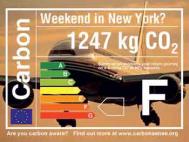NOW THAT THE Kyoto Protocol has been ratified by Russia, and carbon trading has begun on the stock exchange, it will hopefully be only a matter of time before the principles of Contraction and Convergence (C&C) are adopted by governments worldwide. C&C addresses all the concerns the Americans cited as reasons for not signing the Kyoto Protocol, and it is generally regarded as the way forward for reducing global CO2 emissions.
C&C calculates that, given a global population of six billion, each member of humanity can emit up to two tonnes of CO2 per year - a rate that planetary systems would be able to sustain. However, given that the human population is set to rise exponentially for the foreseeable future, this figure will inevitably need to be reduced. Currently, the average UK yearly CO2 emissions per person is approximately twelve tonnes. Clearly, we need to rethink our lifestyles in order to reduce our personal carbon emissions, but in order to do this we need to know how much CO2 our various activities produce.
This is where the Carbon Calculator comes in. Resurgence has commissioned the development of a simple-to-use calculator which will enable readers to work out their approximate CO2 emissions. Obviously the calculator cannot be one hundred per cent accurate, as every car or central heating system will be more or less efficient depending on its design - but a general figure can be worked out, which will indicate where emissions are highest. For some, it may come as a pleasant surprise that their emissions are in line with C&C - but for most of us, even those who actively pursue a 'green' lifestyle, working out one's emissions can be quite a shock.
For example, the average mileage per year in a petrol car is 12,000. This equates to approximately 4.3 tonnes of CO2 per year - over twice our total annual share. What can be done here? The major issue is to look at how we can reduce car journeys - by shopping locally, walking our children to school, using buses and trains where possible, and so on. Reducing car use is the easiest way to reducing emissions. Beyond that, converting a petrol car to run on liquid petroleum gas (LPG) will give an annual CO2 saving of almost one tonne per year, presuming you drive around 12,000 miles. Since 1999 the UK fleet of LPG vehicles has grown from 3,000 to 107,000 cars, representing a saving of more than 70,000 tonnes of CO2 per year. LPG emissions also contain ninety per cent fewer carcinogenic particulates than diesel and LPG is a lot cheaper, at around 38p per litre as opposed to 82p for petrol. The Energy Saving Trust is providing grants of around £700 per vehicle towards the cost of conversion for cars that are less than five years old. Conversion costs are typically around £2,000 per car.
Other ways to reduce transport emissions would be to car-share, negotiate to work a few days a week from home, and use the train or bus where possible. The average car occupancy is approximately 1.2 persons. So filling a car to four people reduces one's personal quota by a quarter for that journey. 12,000 miles travelled by train or bus would equate to 1.2 tonnes of CO2 - far less polluting than travelling by car.
A return flight to Greece will emit approximately one tonne of CO2 per person, but as this pollution is emitted in the upper atmosphere, it is approximately three times more damaging. Therefore, for our calculator, we give a return flight to Greece a three-tonne CO2 load. From this it is obvious that to keep in line with C&C, air travel must be occasional. Some years ago Hazel Henderson, an economist and 'futurist', suggested that a time will come when air travel is rationed. Each person will be given a personal flight quota, and just as is currently happening with industrial carbon trading, she envisaged that those who want or need to fly more will be able to buy quotas from those who do not.
In any case, a good idea to offset our CO2 emissions in the short to medium term would be to plant enough trees to absorb the CO2 - an idea that has been developed by Future Forests www.futureforests.com. Together with their research partners, they calculate how many trees need to be planted to offset the carbon from any particular flight. One mature tree will offset one tonne of CO2 - this carbon-offset service can be bought via their website, to make any given flight 'carbon neutral'.
As long as trees are not rotting or combusting, they lock up carbon in their wood. This fact has been pounced on by the advertising industry - a recent advert in The Guardian suggested that if you are worried about global warming you should buy wooden products: wooden windows, doors, floors and furniture all sink carbon and thus help combat global warming.
In Resurgence 224 Antony Turner from CarbonSense www.carbonsense.org argued that just as we have labels on clothing giving the size and material of the item, in future we will have the carbon load or carbon offset of a product detailed on the label, too. This would be a useful tool in calculating carbon emissions, as most products have a CO2 load. Clothes in particular can be quite heavy in this respect. Designer Katharine Hamnett has created a range of clothes that have been sustainably produced. From organic cotton and recycled metal zips to shipping via sea freight (although not yet under sail) rather than air, Hamnett is addressing the carbon load her products create. To have this load stated on a label would be a useful tool for her customers. For information, visit www.katharinehamnett.com.
A major area of CO2 emissions is household heating. Natural gas emits half the amount of CO2 per kilowatt hour as does electricity - although both are fossil fuels. Burning sustainably grown wood using a woodchip boiler is a good option as this is theoretically 'carbon neutral': the CO2 emitted during combustion of the wood will in theory be sunk by the growing coppice that is later felled for fuel. Effective insulation is the best way of ensuring minimum heat loss from a house and therefore the reduction of fuel need. Single-glazed windows can lose as much as fifty per cent of the heat in a house. A layer of wood cladding on the outside of a stone-built house can reduce heat loss by eighty per cent, as wood is a better insulator than stone by a factor of thirty.
These are just some ways of reducing one's personal carbon quota and future 'Small Steps' columns will address this issue further. In the meantime, why not take a look at our TOKEN4242 and begin the small step of working out your household's emissions? Knowledge is power, and once we know what our CO2 emissions are, we can begin to do something about it.
www.resurgence.org/carboncalculator
The Carbon Calculator has been researched and developed by Mukti K. Mitchell, an environmental designer and boat builder who also undertakes energy audits. Contact [email protected].
Lorna Howarth is co-editor of Resurgence.








